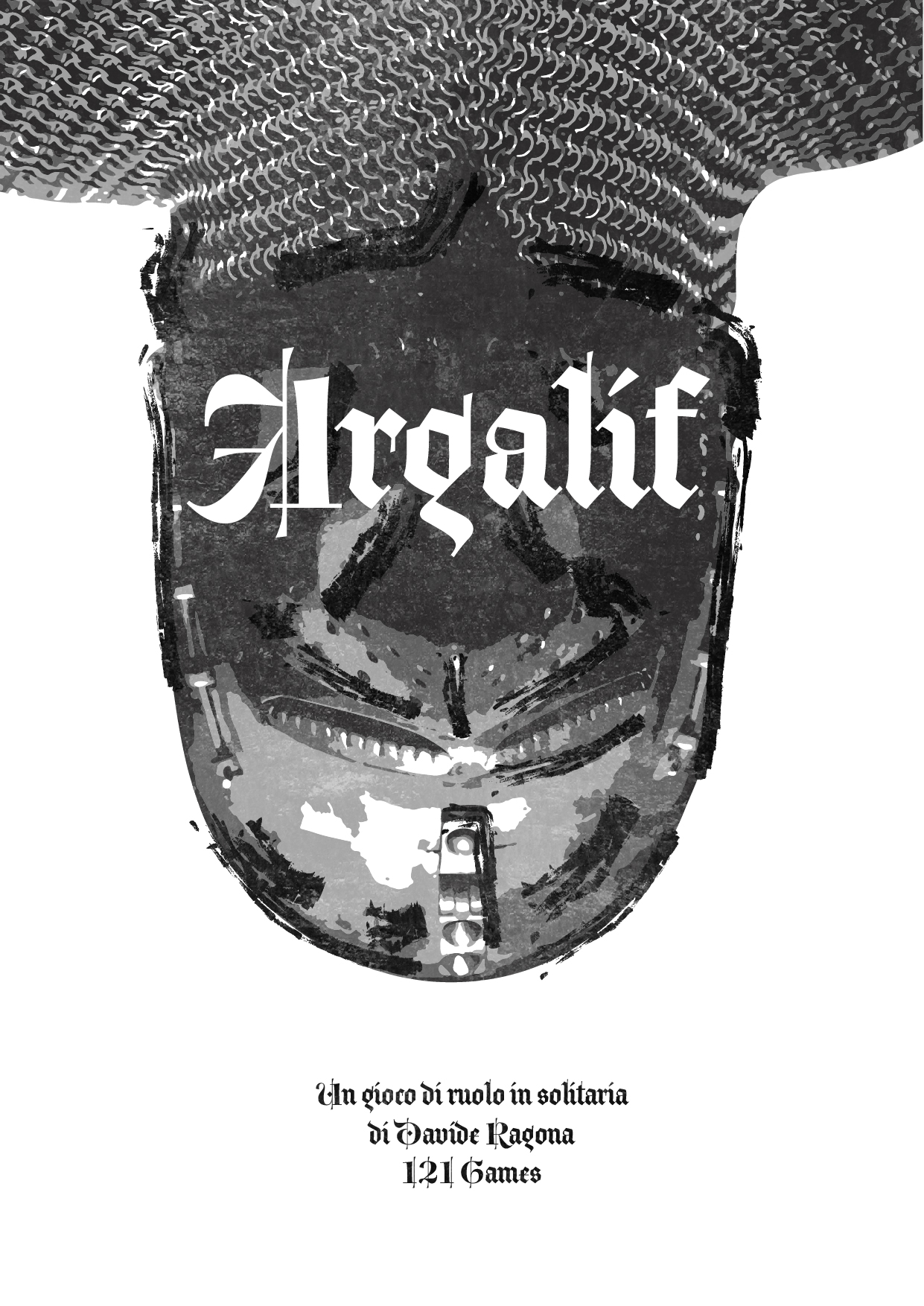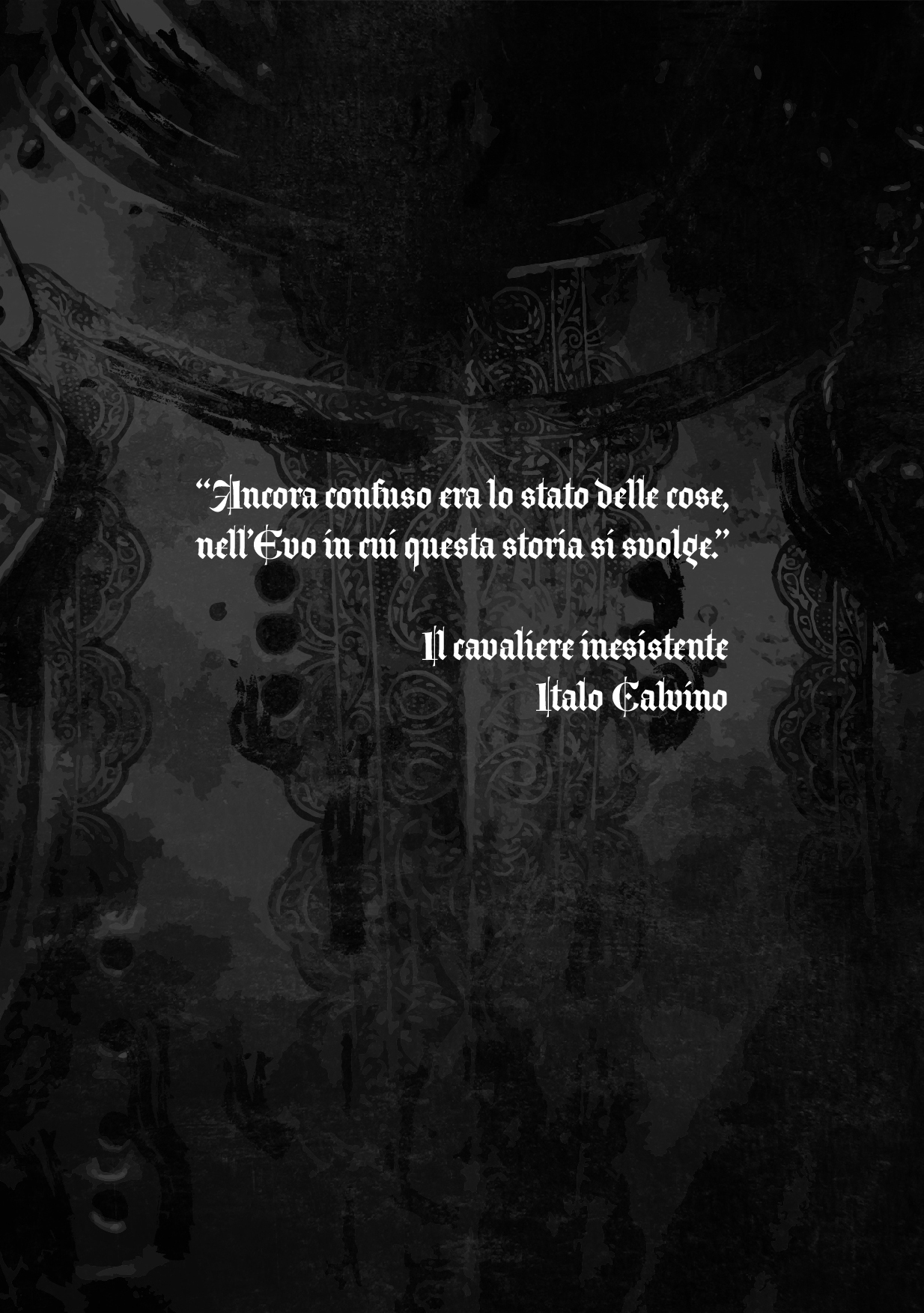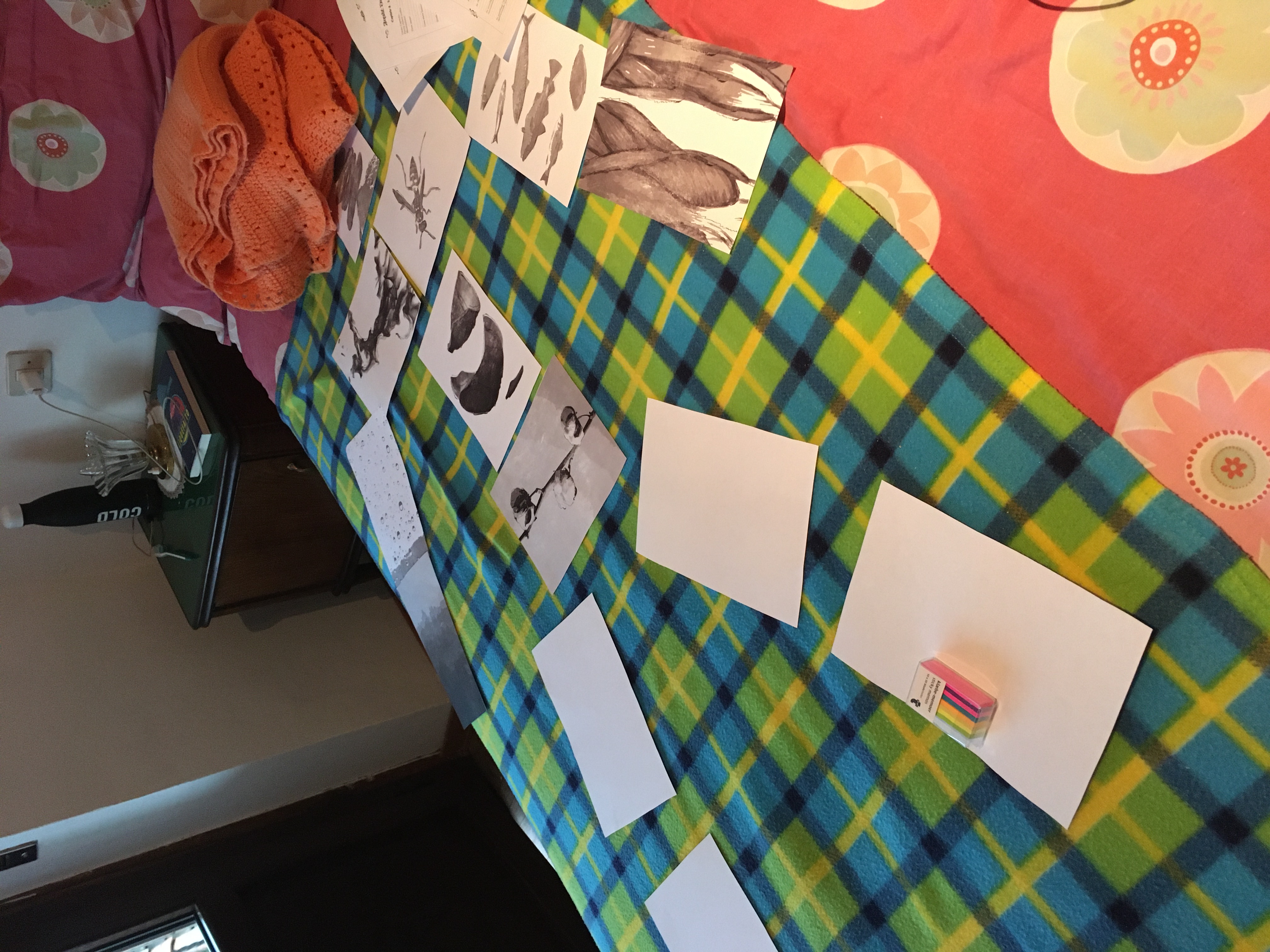Ciao a tutti,
con molta fatica, a causa del poco tempo che riesco a dedicare alla creazione del gioco per questioni di lavoro, ho iniziato solo negli scorsi weekend liberi a lavorare sul regolamento e il design di Argalif.
Vi copio qui gli appunti da cui sono partito, sperando che possano essere utili a tutti, fornendo una sorta di backstage del progetto.
Il libro di Calvino di riferimento per il gioco, volevo che fosse Il Cavaliere Inesistente, perché tra i vari temi c’era quello della vendetta.
Prime considerazioni.
Il tema del gioco sarà incentrato sul senso di dolore (non solo fisico) dato dal ferirsi e cercare di proteggersi.
Siamo in pieno medioevo.
Il gioco racconta la storia di un personaggio che vuole uccidere l’Argalif per vendetta. L’Argalif è uno spietato guerriero nemico.
La vendetta si potrà compiere soltanto dopo aver attraversato il campo di battaglia di una guerra sulle colline francesi.
L’attraversamento del campo porterà delle sfide per il personaggio, che dovrà superarle costruendosi man mano un’armatura, fatta di oggetti fisici reali, a protezione del proprio corpo e delle memorie che lo compongono.
La componente visiva e fisica del gioco sarà centrale, il giocatore dovrà avere di fronte a sé un “corpo reale ma metaforico” con cui interagire e su cui costruire la propria armatura. Questo servirà a non rendere solo teorica e raccontata la propria storia di vendetta.
Il corpo del personaggio sarà composto da tessere estratte su cui si trovano delle illustrazioni simboliche che rappresenteranno dei ricordi del protagonista.
Il gioco dovrà avere uno storytelling emergente, ma con una parte più giocosa lasciata ai dadi, che permetta di non rendere scontate le sfide e l’epilogo, che metta in gioco un po’ di sfida con conseguente coinvolgimento ludico e che strizzi l’occhio ai giochi di stampo classico per evocare un sapore leggero che verrà però messo in discussione dall’emergere della ferocia della vendetta e dal dolore che essa provoca.
La durata non dovrà essere eccessiva, si potrà chiudere il tutto in una sessione.
Per “registrare” l’intera vicenda ci dovrà essere qualcosa che rimane (Un diario? Una registrazione vocale?).
Possibilità di customizzazione data dal poter creare le proprie tessere disegnate (o eventualmente realizzate dalla community). In seconda istanza, volendo dare in mano a chi gioca, più libertà creativa, si può decidere di avere anche storie raccontate non con umani protagonisti, e magari in epoche e scenari differenti, permettendo di scrivere delle skin (protagonista animale, alieno, etc).
Da queste premesse ho iniziato ad imbastire il regolamento, cercando di capire come far emergere la storia, quali meccaniche usare per gli scontri, come intrecciare queste sue componenti e come creare un crescendo narrativo che abbia consistenza per il giocatore.
Altra sfida emersa dai primissimi playtest e dalla minima esperienza accumulata da alcuni giochi che ho scritto fino ad oggi, era il come rendere accessibile e semplice per chi non è abituato a inventare storie, il processo creativo che porta ala nascita di un racconto.
Sin da subito, poiché è presente anche nei primi appunti, volevo che il gioco avesse una componente fisica, per aumentare il coinvolgimento spaziale del giocatore. Non volevo che il corpo/caratteristiche del personaggio venisse relegato a una semplice scheda ma che potesse essere steso di fronte al giocatore, per aumentare l’immedesimazione e lateralmente ricordare in modo inconscio un corpo morto steso a terra. Inoltre doveva essere visivamente e a livello di design, poetico e concettuale, proprio come il Cavaliere inesistente del romanzo, il cui corpo è fatto di volontà e non di carne e ossa.
Da qui è nata l’idea di rendere il corpo su cui giocare, un insieme di concetti che sono poi diventati a livello di design, l’utilizzo di illustrazioni affiancate su fogli A5, di cui è composto il manuale.
Ho provato a vedere come potevo sintetizzare la forma di un corpo accostando dei fogli. Il risultato visivo era di forte impatto emotivo. Avevo fisicamente di fronte a me, il mio cavaliere in cerca di vendetta.
Sono passato poi a chiedermi come far emergere da questo corpo la storia e qui mi sono venuti in aiuto i pezzi dell’armatura che volevo costruire fisicamente sul corpo. Chi gioca in solitario, lo fa solitamente in casa propria dove sono disponibili gli oggetti che ci appartengono e a cui siamo legati. Questi oggetti di per sé sono storie che ci rappresentano. Potevano quindi essere usate per semplificare la narrazione nascendo da stimoli di vita vissuta, inoltre avrebbero aumentato il bleed tra giocatore e personaggio.
A questo punto ho pensato che il gioco poteva essere strutturato a capitoli e ogni capitolo poteva essere la risposta a una domanda. Tutto ciò mi sembrava utile per rendere più accessibile la fase di creazione di contenuti emergenti. Tutti questi elementi potevano essere un gancio per aiutare a inventare la propria storia di vendetta.
Poi sono passato alla parte ludica e di sfida, che volevo ci fosse. Per me in un gioco è importante la semplicità delle regole, che però possano essere di supporto a temi più introspettivi e profondi, così che da un lato il giocatore possa sentirsi coinvolto a livello di sfida, ma dall’altra parte, non dandogli regole troppo complesse, si possa concentrare di più sulla parte di esperienza di gioco. Questo è sicuramente difficile da ottenere, ma è quello che mi piace da giocatore: regole semplici, narrazione ampia e imprevedibilità degli eventi come spinta per creare situazioni varie.
Ho quindi iniziato a creare una sorta di sistema di combattimento molto semplificato, che potesse rendere l’idea di uno scontro in battaglia, dove spesso è un solo colpo a decidere come andrà a finire. Prima di giungere allo scontro finale con l’Argalif, si sarebbero dovuti affrontare degli avversari di difficoltà sempre crescente. Non mi interessava che l’esito di questi scontri decretasse una vittoria o una sconfitta, ma che invece questi potessero muovere la narrazione del passato del personaggio, che sarebbe emerso di scontro in scontro. Era molto più interessante esplorare cosa sarebbe rimasto da questi scontri, che non sono altro che metafore di un percorso che porta inevitabilmente all’Argalif, ovvero ad affrontare il concetto di cosa rappresenta la vendetta.
Per oggi direi che è abbastanza, Proseguo nella creazione del gioco e vi rimando ad altri futuri approfondimenti.
——————————————
Hello everybody,
with a lot of effort, due to the short time that I can devote to the creation of the game for work reasons, I started in the last few free weekends to work on the rules and the design of Argalif.
I copy here the notes I started from, hoping that it will be useful to everyone, providing a sort of backstage of the project.
I wanted Calvino's reference book for this project to be The Non-existent Knight, because among the various themes there was that of revenge.
First considerations.
The theme of the game will focus on the sense of pain (not just physical) caused by injuring oneself and trying to protect oneself.
We are in the middle of the Middle Ages.
The game tells the story of a character who wants to kill the Argalif for revenge. The Argalif is a ruthless enemy warrior.
Revenge can only be accomplished after crossing the battlefield of a war in the French hills. Crossing the field will bring challenges for the character, who will have to overcome them by gradually building an armor, made of real physical objects, to protect his body and the memories that compose it.
The visual and physical component of the game will be central, the player must have in front of him a "real but metaphorical body" with which to interact and on which to build his own armor. This will not only make your story of revenge only theoretical and told.
The character's body will be composed of extracted tiles on which there are symbolic illustrations that will represent memories of the protagonist.
The game must have an emerging storytelling, but with a more playful part left to the dice, which allows the challenges and the epilogue not to be taken for granted, which involves a bit of a challenge with consequent playful involvement and winks to classic games to evoke a taste that will however be questioned by the emergence of the ferocity of revenge and by the pain it causes.
The duration should not be excessive, you can close everything in one session.
To "record" the whole story there must be something that remains (A diary? A voice recording?).
Possibility of customization given by being able to create your own cards design (or possibly made by the community). Secondly, if you want to give those who play more creative freedom, you can decide to also have stories told not with human protagonists, and perhaps in different eras and scenarios, allowing you to write new game skins (animal protagonist, alien, etc.) .
From these premises I started to baste the regulation, trying to understand how to bring out the story, which mechanics to use for the duels, how to intertwine these components and how to create a narrative crescendo that has consistency for the player.
Another challenge that emerged from the very first playtests and from the minimal experience accumulated by some games I wrote before, was how to make the creative process that leads to the birth of a story accessible and simple for those who are not used to inventing stories.
Right from the start, since it is also present in the first notes, it was that the game had to have a physical component, to increase the player's spatial involvement. I wanted the character's body not to be relegated to a simple character sheet but that it could be laid out in front of the player, to increase identification and laterally unconsciously remember a dead body, which is lying on the ground. It also had to be poetic and conceptual, just like the Non-existent Knight in the novel, whose body is made of will and not of flesh and blood.
Hence the idea of making the body of the character the game itself, a set of concepts that later became at the design level, the use of illustrations placed side by side on A5 sheets, which make up the manual.
I tried to see how I could synthesize the shape of a body by juxtaposing sheets. The visual result was of strong impact. I had physical and in front of me, my knight seeking revenge.
I then went on to ask myself how to make history emerge from this body and here the pieces of armor that I wanted to physically build on the body came to my aid. Those who play a solo rpg game usually do it in their own home where there are a lot of objects that belong to us and to which we are linked. These objects in themselves are stories that represent us. They could therefore be used to simplify the narration, arising from real life stimuli, and they would also have increased the bleed between player and character.
At this point I thought that the game could be structured in chapters and each chapter could be the answer to a question. All this seemed useful to me to make the phase of creating emerging content more accessible. All of these elements could be a hook to help make up your own revenge story.
Then I moved on to the playful and challenging part, which I wanted there. For me in a game the simplicity of the rules is important, but they can support more introspective and profound themes, so that on the one hand the player can feel involved at the level of the challenge, but on the other hand not giving him too complex rules. You can focus more on the experience part of the game. This is certainly difficult to achieve for a designer, but it is what I like as a player: simple rules, broad storytelling and unpredictability of events as a push to create varied situations.
I then started to create a sort of very simplified combat system, which could give the idea of a fight in battle, where often it is a single shot that decides how it will end. Before reaching the final clash with the Argalif, opponents of increasing difficulty would have had to be faced. I did not care that the outcome of these clashes was a victory or a defeat, but that instead these could move the narrative of the character's past, which would emerge from battle to battle. It was much more interesting to explore what would have remained from these clashes, which are nothing more than metaphors of a path that inevitably leads to the Argalif, or to address the concept of what revenge represents.
For today I would say that it is enough, I continue in the creation of the game and I refer you to other future insights.





